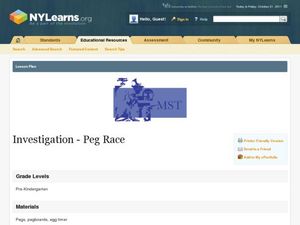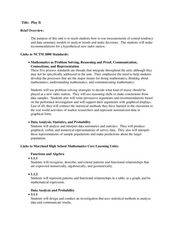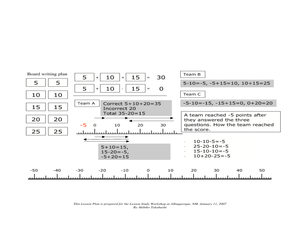Curated OER
Number Wizards! Lesson Plan
Students play a game in which they build and compare large numbers to learn place value. They use place value to read, write and compare large numbers.
Curated OER
Investigation - Distribution
Students match match one notice with one child for all children in their group. They will determine the correct number of notices needed by for the children in their group. Through activities, students discover one-to-one correspondence...
Curated OER
Investigation - Representing Place Value
Third graders demonstrate models to represent a 3 digit counting number. They use manipulative materials to represent place value in whole numbers. Students represent numbers in expanded notation.
Curated OER
Problem Solving Strategy for Multi-step Math Problems
Third graders analyze mathematical word problems and interpret the words into mathematical equations. Individuals demonstrate their knowledge of the order of operations both verbally and through written expression.
Curated OER
Investigation - The Bakery Shop
Students use manipulatives to establish quantity. By singing a song titled "Five Little Cookies," students determine which strategy to use to find out how many cookies are left in the bakery shop.
Curated OER
Positive and Negative Numbers
Pupils use blocks and markers to illustrate the processes of adding, subtracting, multiplying and dividing integers. In this mathematics lesson, learners use Algebra blocks to demonstrate multiplying polynomials.
Curated OER
Investigation - Patterns/Functions
Learners will display the first five rows of Pascal's Triangle and discuss in their groups what patterns they see in the rows of numbers. They will give responses and discuss that these numbers form what is called Pascal's Triangle.
Curated OER
Investigation Can You Build This?
Students work in small groups to explore spatial relationships while building with color cubes. Students must identify positions of blocks to partner, recreate a model, and color a sketch of their structure appropriately.
Curated OER
Investigation - Peg Race
Students explore time by comparing the duration of an egg timer with how many pegs they can put in a pegboard. They experience one on one correspondence, as they place a peg in the whole. Students discover estimation of time and number...
Curated OER
Sorting and Classifying
Fifth graders are engaged in sorting and classifying geometric shapes of various colors and sizes. They discuss the properties of these shapes and illustrate a range of classifications using Venn diagrams.
Curated OER
Investigation - What's the Number?: Division
Seventh graders explore number sentences using a variety of strategies making each equation a true sentence. Students examine strategies such as patterns, trial and error, working backwards, and related problems. In groups, 7th graders...
Curated OER
Play It
There are a number of activities here that look at representing data in different ways. One activity, has young data analysts conduct a class survey regarding a new radio station, summarize a data set, and use central tendencies to...
Curated OER
Investigating Velocity Effects at Takeoff
Young scholars use, with increasing confidence, problem-solving approaches to investigate and explain mathematical content. They make and test conjectures. They use tables and graphs as tools to interpret expressions, equations, and...
Curated OER
Fact Families - 6, 7, and 42
Students investigate the problems that can be solved only using the numbers 6, 7, and 42. They write the correct number sentences and solve for the solution. Students then give a written explanation for how the problem was solved and the...
Curated OER
Harvest Halloween
First graders brainstorm mathematic manipulatives to assist them with a given set of problems. They work in pairs or small groups and write and/or draw to explain how they solved the problem.
Curated OER
The Fibonacci Sequence
Students investigate a numerical pattern and look for evidence of mathematical patterns in nature. They solve puzzles and work with a partner to predict sequential numbers in a series.
Utah Education Network (UEN)
It's All Just Similar to Me
Middle schoolers explore the concept of similar figures. In this similar figures lesson, pupils calculate scale factors of similar triangles. They find missing sides of triangles, and measure angles using protractors and measure sides of...
Curated OER
Playing Math Fever
Pupils complete activities to learn notation and uses for positive and negative numbers. For this number system lesson, learners play a game similar to Jeopardy to learn how to solve problems with positive and negative numbers.
Illustrative Mathematics
Egyptian Fractions II
The Egyptians used unit fractions to describe all other fractions. Your class will rewrite rational expressions in order to deduce information about rational numbers. The activity starts with specific fractions, guides you through a few...
Illustrative Mathematics
Firefighter Allocation
Creating equations with one variable to solve real-world-type problems is a key skill any algebra learner needs to master. Here the focus is on realizing that one can write the equation in different ways depending upon how one...
Curated OER
Building Numbers to 50
Students explore how to represent numbers using cubes and draw them accordingly. They discuss place value and the base ten number system using manipulatives. Students roll a dice and take that many blocks. They write down their resulting...
Illinois State Board of Education
Is It Linear?
Math apprentices are introduced to the components of a linear relationship. In groups, they write story problems that incorporate this relationship and relates to the real world. They give their problem to the class for them to solve.
Curated OER
Seeing Is Believing
Students investigate the concepts of probability. They use data to find the central tendency, median, and mode. Students design and play a game in order to practice the concepts. They also complete a table with data that is analyzed.
Curated OER
Tessellations: Geometry and Symmetry
Young scholars explore the concept of tessellations. In this tessellations lesson, students use an applet to construct tessellations. Young scholars use regular polygons to construct tessellations. Students find patterns and symmetry in...

























